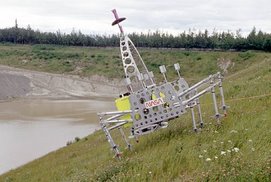Swarms of intelligent robots that can clean, tidy and even attend to patients remotely could revolutionise the provision of healthcare in hospitals. It is hoped these robotic nurses could patrol and monitor wards, dealing with problems and easing the burden on hospital staff.
The EU-funded project, known as IWARD, will be co-ordinated by the Fraunhofer Institute in Germany and involve collaboration between European academic institutions, including the universities of Cardiff, Dublin and Newcastle.
Project leader Thomas Schlegel, from Fraunhofer's human-computer interaction division, says the robots could also help hospitals cut MRSA infections on wards by keeping them cleaner.
Each will consist of a basic platform on to which a module of sensors and equipment for different tasks would be mounted. This is being developed at Newcastle University. For example, a robot would be fitted with a laser thermometer to allow it to remotely monitor a patient's temperature, or fitted with cleaning equipment to mop up spills. They will communicate with each other and co-ordinate tasks when appropriate.
While the hardware and modules will use off-the-shelf technology as much as possible, the swarm-based intelligence will demand ground-breaking work, according to Schlegel. Fraunhofer is working with Warwick University to develop this innovative software platform to allow the robots to operate semi-autonomously.
'The idea is not only to have mobile robots but also a full system of integrated information terminals and guide-lights, so the hospital is full of interaction and intelligence,' said Schlegel. 'Operating as a completely decentralised network means that the robots can co-ordinate things between themselves, such as deciding which one would be best equipped to deal with a spillage or to transport medicine.'
Schlegel envisages the robots will be used for a wide range of tasks. One would be to guide people around the hospital. A visitor could tell a fixed information terminal the name of a patient he wanted to visit and a robot would lead him to their bedside. If the nearest robot was not sure of the patient's location it could communicate with others in the area to see if they could help.
Each robot will be fitted with a suite of sensors allowing it to move around the hospital, using proximity sensors to avoid collisions and inbuilt cameras to explore its environment. One robot will be able to warn another if its cameras see a collision is likely. High-speed lanes to allow the robots to move around quickly could also be installed.
Information will be passed between the robots using a wireless LAN or technology such as Bluetooth but they will also be able to use other forms of communication including infrared lasers.
The robots will communicate with patients, pass messages or perform basic tasks. 'The human-robot interaction will be tricky as the robots will have to be able to deal with people with different injuries and disabilities as well as the elderly and seriously ill patients,' admits Schlegel.
Facial recognition technologies will be employed, so the robots could spot if any unauthorised person had entered their ward.
Schlegel said: 'IWARD will mean that hospital staff will be able to spend more time with their patients rather than doing these other basic tasks.'
By the end of the three-year project, which began this month, the team hopes to have developed a three-robot prototype system.
Fore more info about Job related please click here
Fore science and technology info.; please visit this link.
Subscribe to:
Post Comments (Atom)







No comments:
Post a Comment